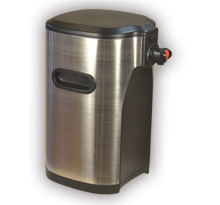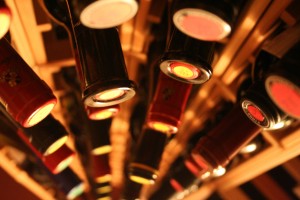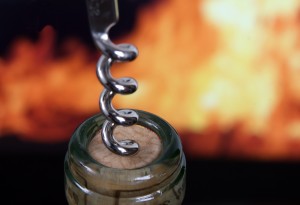by Lorri | Jul 10, 2013 | Tips, UnCorked
 As I write this column I have just returned home from a long, relaxed stay in Spain with my family. (Many columns to come about my adventures and discoveries in the Iberian peninsula). As I made my way through the numerous airports I realized my wine travel tips might be immediately relevant to those of you with suitcases already packed and travel confirmed.
As I write this column I have just returned home from a long, relaxed stay in Spain with my family. (Many columns to come about my adventures and discoveries in the Iberian peninsula). As I made my way through the numerous airports I realized my wine travel tips might be immediately relevant to those of you with suitcases already packed and travel confirmed.
For those of us who travel frequently it’s common to keep a wine opener in our bags. I always keep one in my briefcase, because on one trip years ago the only help the front desk of my hotel could offer was a metal fork. (Oddly enough, with patience and precision, I actually got the fork to work.)
When traveling by plane, make sure you pack the opener in your checked luggage. A wine opener is only handy to have until it is confiscated during the security screening. It happened to me this trip and I must say it was painful to watch as one of my favorite openers was haphazardly tossed into the box of the abyss.
Because we can now carry only very small amounts of liquids on the plane, bringing back bottles of wine poses special challenges. In the past, those few sacred bottles were easily packed in carry-on bags where they wouldn’t be crushed, jostled or otherwise in danger of breaking. Now you need more planning in order to arrive home with your purchase. You can try the old (and risky) strategy of wrapping the bottle in a thick sock, packing it in the center of your suitcase wrapped with clothes and hoping it doesn’t break or leak by the time you reach your final destination. But there’s a better way. There are many options for protecting your bottles in checked luggage. Several of my favorites are the Vinni-Bag (vinnibag.com), Winehug (winehug.com) and Wine Skin (wineskin.net). These products basically create a sturdy air cushion around the bottles. The drawback is they are bulky and take up precious space in a suitcase. The worst part of my trip was the realization that mine were still sitting on my desk at home.
As I was collecting my baggage in customs I noticed that someone else had a red bag with a large logo depicting a wine bottle with wings. After some research I discovered it’s called The Wine Check, and it is what I think could be a smart option for getting our precious cargo safely home. It looks like a square rolling suitcase but is specially designed to hold one case (12 bottles) of wine while staying under the 50-pound limit most airlines allow. I watched the durability test video on the website and was impressed with the results.
If your travel involves wine and an airplane, I hope my own wine travel blunders help you to avoid the same mistakes.
by Lorri | Jun 26, 2013 | Tips, UnCorked
 One of my favorite things about summer is the ability to regularly fire up the grill. We like to grill everything from squash to sausage, which we then top with everything from a simple drizzle of olive oil to a rich slather of barbecue sauce. One thing I’ve noticed over the years is when family and friends arrive it seems they have the urge to gravitate to the cooler filled with beer. I hope these easy tips and recommendations will make your next cookout a wine-friendly affair and help you persuade your guests to close the cooler.
One of my favorite things about summer is the ability to regularly fire up the grill. We like to grill everything from squash to sausage, which we then top with everything from a simple drizzle of olive oil to a rich slather of barbecue sauce. One thing I’ve noticed over the years is when family and friends arrive it seems they have the urge to gravitate to the cooler filled with beer. I hope these easy tips and recommendations will make your next cookout a wine-friendly affair and help you persuade your guests to close the cooler.
Steak and cabernet sauvignon are an ideal match up. Most cuts of steak cry out for a full-bodied, tannic red wine. If you sauce your steak, consider choosing a sauce without a lot of sugar to keep the ideal combination of salty, fat and high-tannin wine flavors.
THE VALUE
- 2011 Bridlewood Estate Cabernet Sauvignon, California (about $15 retail)
THE SPLURGE
- 2010 BR Cohn Silver Label Cabernet Sauvignon, California (about $24 retail)
Salmon and a buttery, oaked chardonnay are wine-pairing perfection. Chardonnays, particularly those from California, can overwhelm many dishes with their oaky, fruity, full-bodied style, but the richness of salmon complements these flavors.
THE VALUE
- 2011 BV Coastal Chardonnay, California (about $11 retail)
THE SPLURGE
- 2011 Argyle Chardonnay, Oregon (about $23 retail)
Burgers and merlot may seem like an odd pairing,but the two work wonderfully together. Merlots tend to share supple, velvety tannins and round black cherry and plum flavors that enhance the smoky earthiness of a grilled burger.
THE VALUE
- 2011 Bogle Vineyards Merlot, California (about $11 retail)
THE SPLURGE
- 2010 Bell Wine Cellars Yountville Merlot, California (about $40 retail)
When it comes to chicken, many red wines will overpower the delicate flavor, but sometimes a red is exactly what you want. Chicken with heavy sauce or cheese requires a full-bodied wine with intensity, making zinfandel an ideal choice. Most zinfandels have ripe luscious, fruity, spice and vanilla aromas, making the match work. If you are grilling a chicken dish lightly seasoned with a little olive oil and herbs, chardonnay is a sound choice.
THE VALUE
- 2011 Cline Cellars California Zinfandel, California (about $12 retail)
THE SPLURGE
- 2010 Earthquake Zinfandel, California (about $30 retail)
by Lorri | Jun 19, 2013 | Tips, UnCorked
 Dispensers to make boxed wine look stylish in your kitchen and washable markers for writing names on glasses are just two of the gadgets or ideas I have seen in the past couple of months worth talking about.
Dispensers to make boxed wine look stylish in your kitchen and washable markers for writing names on glasses are just two of the gadgets or ideas I have seen in the past couple of months worth talking about.
THE BOX MAKEOVER
I am not a wine snob when it comes to buying boxed wine. I would consider myself the opposite. Boxed wine stays fresh longer than the traditional glass bottle and has the bonus of being environmentally friendly. I’m not alone in the support of the box. A multitude of quality producers are working to change the image of boxed wine. Yet even with my confidence and support it’s challenging to not judge the humble cardboard box and its ability to compete with the aura of the bottle.
I came across a stainless-steel wine dispenser for the 3-liter bag in the box, The Boxxle. Buy your brand, open the box and pull out the bladder, place inside the dispenser and, voila, you have a chic and functional product without the cardboard. Boxxle successfully tackles a few other issues as well. Boxxle’s spigot is positioned so the glass sets on the counter, rather than having to bring the box to the edge of the countertop and hold the glass in one hand and work the spigot with the other. Boxxle’s automatic compression also eliminates the need to squeeze the last two or three glasses from the pouch. For more information, visit Boxxle.com
SKIP THE JEWELRY
Not to say they aren’t useful, but the wine charm – those colorful rings that slip on the stems of glasses – has never seemed to work in helping my guests keep up with their wine glass. A person will put down the glass … talk … move to another location and before you know it several people are asking who has the color blue, red or yellow or a lady bug, butterfly or the Eiffel tower. For me, wine glass markers – special pens that write directly on the glass – are a great solution.The marks stay on for the affair, wash away with a sponge or in the dishwater. A few tips from my blunders are to wait about 30 seconds after writing before the guest uses the glass, and if you are serving a chilled wine, write close to the rim and above the pour line. For more information, visit WineGlassWriter.com.
PUT A CAP ON IT
Last but not least is the CapaBunga reusable silicone cap. The cap reseals a bottle of wine after you remove the cork and resembles a bung used to seal barrels during winemaking. After you remove the cork you can reseal the bottle and get a liquid-tight bottle. For those of us who tend to store opened bottles on their sides in the refrigerator to later find the wine has leaked and dripped onto everything below it, this product makes sense. Invented by two winery owners in northern California, the caps show off the designer’s artistic passion with the range of slogans available, for example “in case of in-laws remove cap,” “I’ve earned it,” “me time,” and “retox” as well a solid colors. For more information, visit Capabunga.com.
THE VALUES
- Wine Glass Writer (about $10 retail for a three-pack)
- CapaBunga Reusable Silicone Cap, (about $8 for a two pack or $13 for a four-pack)
THE SPLURGE
- The Boxxle, Box Wine Dispenser (about $100 retail)
by Lorri | Apr 3, 2013 | Tips, UnCorked
 I am sure we could search century-old cellar journals and find early versions of the longstanding question of when is the best time to open a bottle of wine. It’s really rather a conundrum because if you pull the cork too early you’re left with a tannic, acidic wine. Open too late and most likely nothing is left except a dried-out fruitless wine. And worse, if you open years past the appropriate life of the wine you’re stuck with a bottle of vinegar.
I am sure we could search century-old cellar journals and find early versions of the longstanding question of when is the best time to open a bottle of wine. It’s really rather a conundrum because if you pull the cork too early you’re left with a tannic, acidic wine. Open too late and most likely nothing is left except a dried-out fruitless wine. And worse, if you open years past the appropriate life of the wine you’re stuck with a bottle of vinegar.
I wish there was a magic calculation to come up with the right date to open our slumbering bottles. But that magic formula doesn’t exist. So, I offer these general guidelines for those who are questioning whether to pop the cork, or not.
Many wines are saved long past their viable life simply because of the owner’s perception of the wine label. I am asked a lot to quickly survey a collection and to offer advice regarding when certain wines are (or will be) ready to drink. A recurring theme is that the attractive French Bordeaux label leads owners – many of whom receive the bottles as gifts – to think they have a wine that should be aged longer than is necessary. A general rule is French labels stating the general and broad category of “Bordeaux AC” are best consumed within one to two years.
Opening any bottle that has been aging is a hit or miss proposition, especially if you only have one bottle. If you are serious about collecting I recommend buying by the case or at least three bottles. This helps you to determine exactly where the wine is in its maturity and offers you the opportunity to taste it in stages. If you have a case, open one bottle soon after you buy it so you have an indication of where the wine is in the aging process. Take notes and re-visit another bottle later to see how the wine is changing.
Red wines generally agewell because of tannins, the chemical substance that creates the pucker power in a young red wine, which has preservation properties. But keep in mind it’s a myth that a harsh tannic, unbalanced red wine only needs to be kept long enough to become a great wine. The same wine five years down the road will likely still be harsh and unbalanced. The same is true of the widespread thinking that young red wines in balance will not improve or change with time.
Color is one of the best gauges for red or white wines. If you are looking at a young red wine (depending on the grape) it will generally have a more purple rim color. As the pigments oxidize they are precipitated along with the tannins becoming more ruby and then gradually a brownish color. Storage conditions, the grape and method of production can also have color impact.
FOR NOW
- 2010 Swinto Old Vine Malbec, Argentina (about $40 retail) to keep for a couple of years.
FOR LATER
- 2007 Bell Vineyards Clone 6, California (about $80 retail) to taste now and until perfection, approximately 8 to 10 years.
by Lorri | Jan 9, 2013 | Tips, UnCorked
 This is the second in a two part column about wines to stock in order to have a variety on hand.
This is the second in a two part column about wines to stock in order to have a variety on hand.
Last week we looked at the first six bottles of wines to consider when starting a collection. This second group rounds out the assemblage with more food-friendly wines for a variety of occasions.
ALWAYS THE SEASON
Of course port is ideal during Thanksgiving and Christmas, but it is often overlooked as the perfect dessert wine or ending to a meal. Vintage port can command high prices – from hundreds of dollars and beyond, depending upon the year. But the high price doesn’t mean budget-savvy drinkers have to forgo port. The bottle I would have on hand would be another version of port, the tawny port.
Tawny port is identified by age (10 or 20 years old) rather than vintage. The age refers to how long the port matured in the cask. This difference also is reflected in the price, making the tawny a great value to have on hand.
- Taylor Fladgate 10-Year-Old Tawny Port, Portugal (about $35 retail)
FOOD’S BEST FRIEND
Riesling is the ideal foodfriendly white wine. It’s the acidity in the wine that allows almost any food to show off and not be overpowered by tannins or full-bodied style. This grape generally has a lower alcohol level than most white wines, which is another plus.
- 2007 Grand Cru Saering Riesling, France (about $32 retail)
FAMILIAR WHITE
Chardonnay is still the most recognizable grape for most wine drinkers. Many chardonnay styles can be high in oak and high in alcohol. The bottle I would have in my case would be a French style or a balanced, less oaky California. This addition is another wine guests will be familiar with and it pairs with almost every white-meat dish.
- 2011 Louis Jadot Macon-Villages Chardonnay, France (around $13 retail)
THE FRESH ITALIAN
Moscato d’Asti should be enjoyed when it’s young and fresh. This is one of the few wines I would recommend you add to your collection, with the plan being to open it within 3 months of when you bought it. It needs to be served chilled and pairs with an array of foods ranging from breakfast to dessert.
- 2012 Vietti Moscato d’Asti “Cascinetta Vietti,” Italy (about $16 retail)
MUST-HAVE FAVORITE
Gewurztraminer is a great partner for lighter foods and anytime on its own. It is one favorite everyone should have in a collection.
- 2010 Pierre Sparr Gewurztraminer, France (about $18 retail)
A WINE MADE FOR DINING
Last but not least is Chianti. This Italian wine was made for food. The main reason I enjoy having this wine on hand is its effortless way of pairing with a range of foods – from cold pizza to homemade pasta sauces. And there’s no reason to spend a lot of money because many Chiantis can be found for less than $20.
- 2010 Cecchi Chianti Classico, Italy (about $14 retail)
by Lorri | Oct 10, 2012 | Tips, UnCorked
 Up to this moment, even the wine list ordering anxiety was only amateur night compared to the angst of sending back your first bottle of wine. Your spouse is whispering to not draw attention, your guest may not know the difference in a chardonnay and pinot grigio and worse, there’s the impending stare from your waiter, the waiter who clearly thinks you’re trying to impress your dining partners.
Up to this moment, even the wine list ordering anxiety was only amateur night compared to the angst of sending back your first bottle of wine. Your spouse is whispering to not draw attention, your guest may not know the difference in a chardonnay and pinot grigio and worse, there’s the impending stare from your waiter, the waiter who clearly thinks you’re trying to impress your dining partners.
My mentor, wine writer Frank Prial said it brilliantly, “At best you will meet your trial with steadfastness and course … at worst you can console yourself that you’ve come a long way from the days when you were afraid to order the bottle in the first place.”
It’s not easy rallying the nerve to send a bottle of wine back or even questioning its condition but there are a few pointers and etiquette guidelines that can help ease the stress.
The ritual remains the same: The waiter opens the bottle, the person who ordered the wine will be asked if he would like to taste. Answer yes, and the waiter will pour a small amount. The diner will give it a quick sniff and take a sip, nodding yes if the wine is not tainted. Obviously, if the wine smells like a musty basement, dirty socks or vinegar you will tell your waiter, who will usually confirm the fault, retrieve a new bottle and begin again.
If you are dining in a restaurant with a knowledgeable staff this task will not be a debate or embarrassing conflict. Your waiter is opening the bottle for the first time at your table so consider from the beginning he is your ally. If you think the bottle has a fault, ask the waiter to taste the wine and offer his opinion. Knowledgeable staff will be able to evaluate and discuss the fault or aroma you are detecting.
Of course it doesn’t make sense to go through an entire dining experience with a bad bottle but there is a difference in a flaw and simply not enjoying the taste. Many times when ordering an unfamiliar varietal, vintage or region, the wine will express itself differently from traditional wines we drink on a regular basis.
This is important because many wines will have an unusual or unfamiliar aroma or taste very specific to the grape. For example, a beautiful old Burgundy pinot noir may have the aromas of barnyard, manure and a touch of mushrooms. It is important to understand this is not a fault but a unique character to the aging wine. Consider asking for a “tasting” pour, if the wine is available by the glass as well as bottle. This helps in the taste and fault confusion before ordering the bottle.
A last tip: the stemware could be the culprit. With industrial restaurant detergents and dishwashers, residue left on the glass can offset the aromas. Sometimes it may be as simple as asking to re-taste in a fresh wine glass.
 As I write this column I have just returned home from a long, relaxed stay in Spain with my family. (Many columns to come about my adventures and discoveries in the Iberian peninsula). As I made my way through the numerous airports I realized my wine travel tips might be immediately relevant to those of you with suitcases already packed and travel confirmed.
As I write this column I have just returned home from a long, relaxed stay in Spain with my family. (Many columns to come about my adventures and discoveries in the Iberian peninsula). As I made my way through the numerous airports I realized my wine travel tips might be immediately relevant to those of you with suitcases already packed and travel confirmed. One of my favorite things about summer is the ability to regularly fire up the grill. We like to grill everything from squash to sausage, which we then top with everything from a simple drizzle of olive oil to a rich slather of barbecue sauce. One thing I’ve noticed over the years is when family and friends arrive it seems they have the urge to gravitate to the cooler filled with beer. I hope these easy tips and recommendations will make your next cookout a wine-friendly affair and help you persuade your guests to close the cooler.
One of my favorite things about summer is the ability to regularly fire up the grill. We like to grill everything from squash to sausage, which we then top with everything from a simple drizzle of olive oil to a rich slather of barbecue sauce. One thing I’ve noticed over the years is when family and friends arrive it seems they have the urge to gravitate to the cooler filled with beer. I hope these easy tips and recommendations will make your next cookout a wine-friendly affair and help you persuade your guests to close the cooler. Dispensers to make boxed wine look stylish in your kitchen and washable markers for writing names on glasses are just two of the gadgets or ideas I have seen in the past couple of months worth talking about.
Dispensers to make boxed wine look stylish in your kitchen and washable markers for writing names on glasses are just two of the gadgets or ideas I have seen in the past couple of months worth talking about. I am sure we could search century-old cellar journals and find early versions of the longstanding question of when is the best time to open a bottle of wine. It’s really rather a conundrum because if you pull the cork too early you’re left with a tannic, acidic wine. Open too late and most likely nothing is left except a dried-out fruitless wine. And worse, if you open years past the appropriate life of the wine you’re stuck with a bottle of vinegar.
I am sure we could search century-old cellar journals and find early versions of the longstanding question of when is the best time to open a bottle of wine. It’s really rather a conundrum because if you pull the cork too early you’re left with a tannic, acidic wine. Open too late and most likely nothing is left except a dried-out fruitless wine. And worse, if you open years past the appropriate life of the wine you’re stuck with a bottle of vinegar. This is the second in a two part column about wines to stock in order to have a variety on hand.
This is the second in a two part column about wines to stock in order to have a variety on hand. Up to this moment, even the wine list ordering anxiety was only amateur night compared to the angst of sending back your first bottle of wine. Your spouse is whispering to not draw attention, your guest may not know the difference in a chardonnay and pinot grigio and worse, there’s the impending stare from your waiter, the waiter who clearly thinks you’re trying to impress your dining partners.
Up to this moment, even the wine list ordering anxiety was only amateur night compared to the angst of sending back your first bottle of wine. Your spouse is whispering to not draw attention, your guest may not know the difference in a chardonnay and pinot grigio and worse, there’s the impending stare from your waiter, the waiter who clearly thinks you’re trying to impress your dining partners.